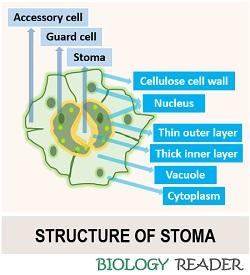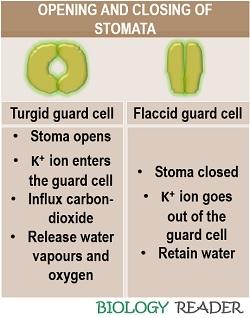Stomata in plants appear as minute pores, primarily in the epidermis layer of the leaf surface and rarely in some of the herbaceous stems. It was originated from the Greek word stoma (means mouth) to relate it with the term “stomatal pore”. A stoma is a singular form, whereas a high number of stoma is termed stomata (a plural form).
A stoma or stomatal pore is flanked by the two guard cells, which appears more or less similar to the human lips. Guard cells surrounding the stoma function to expand and contract to mediate stoma opening and closing. Apart from stoma and guard cell, some accessory cells surround the guard cells and control the guard cell’s movement.
Stomata are prevalently seen in vascular plants. In this context, we will discuss the meaning structure, number, types, opening-closing mechanisms and functions of the stomata.
Content: Stomata in Plants
Stomata Meaning
A stoma refers to a tiny aperture generally found in the epidermis layer of the leaves. The number of stomata varies among plants of different species. In the adaxial leaf surface, the number of stomata is usually less in quantity and more confined to the leaf’s abaxial surface. Stoma resembles the mouth, whose opening and closing is mediated by the guard cells. We could take a reference of guard cell with the lips, as it surrounds the stoma.
One more specialized or modified epidermal cell is adjacent to the guard cell called subsidiary or accessory cells. In plants, stomata are present prevalently in the leaves and rarely in stems, fruits, stamens, petals and gynoecia. A root system lacks the presence of stomata.
Structure of Stoma
Stomata contribute to 1-2% of the leaf area when it is open. It includes the following structural characteristics:

- Shape: The shape of the stoma is generally “Elliptical” but vary among different plant species.
- Size: When the stoma is open, it measures a width of 3-12 mm and a length of 10-40 mm.
- Guard cell: There are two specialized guard cells. A guard cell possesses a kidney shape in dorsiventral leaves, while a dumb-bell shape in isobilateral leaves. An inner layer of guard cell surrounding the stomata is generally thick-walled and inelastic. Conversely, the rest of the outer layer surrounding a guard cell is thin-walled, flexible and semi-permeable. It consists of a central vacuole, cytoplasmic lining, single nucleus and a few chloroplasts. The chloroplasts in guard cell are non-functional and result in reduced photosynthesis as they lack the enzyme Rubisco.
- Subsidiary cells: Apart from stoma and guard cells, some modified epidermal cells or accessory cells help in the movement of the guard cell. It also consists of a cytoplasmic layer, a large central vacuole, a single nucleus and lacks chloroplast.
Number of Stomata
It ranges from 1000 to 60,000 stomata per square centimetre and called the “Stomatal frequency”. In isobilateral leaves, the number of stomata is approximately the same on both the adaxial and abaxial epidermis. However, the stomata are more confined to the adaxial epidermis than the abaxial epidermis in dorsiventral leaves.
Types of Stomata in Plants
It can be classified into different types based on their location, structure and development.
Based on Stomata Location
There are four types of stomata, depending on the stomata location.

- Epistomatic: In this type, stomata exist in the upper leaf surface. Example: Waterlily
- Heterostamatic: In this type, stomata exist in large number on the lower surface of the leaf. Example: Potato, cabbage etc.
- Isostomatic: In this type, stomata exist equally in both the lower and upper leaf surface. Example: Oats and other grasses.
- Astomatic: It lacks stomata in both the upper and lower leaf surface. Example: Potamogeton and submerged aquatic plants.
Depending upon Stomatal Development
There are three types of stomata based on the kind of development.

- Mesogynous: It is a type of stomatal development, where the guard cells and the accessory cells develop from identical or similar mother cell. Example: Members of the Brassicaceae family.
- Perigynous: It is another type of stomatal development, where both the guard cells and the accessory cells develop from the non-identical or different mother cell. A guard cell develops from a mother cell, and the accessory cells develop from the neighbouring cells. Example: Members of the Cucurbitiaceae family.
- Mesoperigynous: It is a type of stomatal development, which correlates with both misogynous and perigynous type. In mesoperigynous, the guard cells and one accessory cell develop from the single mother cell, while the other accessory cells may develop independently from the neighbouring cells. Example: Members of the Brassicaceae family.
Based on the Stomata Structure
There are seven types of stomata based on their structure.

- Anomocytic: The subsidiary cells surround the ranunculaceous or anomocytic stomata, generally in an irregular fashion and exist less in number. Examples: Members of Ranunculaceae, Malvaceae etc.
- Anisocytic: The subsidiary cells enclose cruciferous or anisocytic stomata that generally exist three in a number of unequal sizes. Examples: Solanum, Nicotiana species etc.
- Paracytic: The subsidiary cells surround the rubiaceous or paracytic stomata that generally exist two in number and lie parallel to each other along the axis of the pore and guard cell. Examples: Solanum, Nicotiana species etc.
- Diacytic: Caryophyllaceous or diacytic stomata are generally surrounded by pairs of subsidiary cells and present 90 Degrees of guard cell. Examples: Acanthacea, Mucaceae species etc.
- Actinocytic: Four or more subsidiary cells radially surround the actinocytic stomata towards the centre of a stoma. Examples: Araceacea, Mucaceae species etc.
- Cyclocytic: This type of stomata comprises four or more subsidiary cells surrounding the guard cell and appears as radially arranged narrow rings. Examples: Palmae, Pandanus etc.
- Graminaceous: It possesses stomata of dumb-bell shape, and the accessory cells surrounding it lie parallel to each other along the longitudinal axis of the stomatal pore. Example: Grameneaceae, Cyperaceae etc.
Opening and Closing of Stomata
Two guard cells mediate the stomatal opening and closing to maintain the plant’s water balance and access CO2. Therefore, the event of opening and closing depends upon the solute concentration of the guard cells.

- Stoma opens when the stomata have a high water potential. Thus, there must be an osmotic movement of solute from high concentration (surrounding) to low concentration (guard cell). This osmotic movement makes the guard cells turgid, where they swell to open the stomatal pore to influx CO2 and efflux water vapours and oxygen.
- Stoma encloses when the stomata have a low water potential. Therefore, there must be an osmotic movement of solute from low concentration (surrounding) to high concentration (guard cell). This osmotic movement makes the guard cells flaccid, where they shrink to close the stomatal pore in order to retain water.
Factors like low and high water concentration, low CO2 content, high-temperature cause stomata opening. Oppositely, factors like mechanical stress, low temperature, and insufficient light cause the closing of stomata.
Functions of Stomata in Plants
Stomata perform two significant roles in a plant:
- An influx of carbon dioxide for photosynthesis in plants.
- To maintain the water balance in the plant cells.
Stoma opens during the daytime when photosynthesis occurs in the presence of sunlight. As we need fuel to cook food, plants harness carbon dioxide as fuel to prepare food for themselves. Therefore, stomata play an essential role in the process of photosynthesis.
Stoma opens or closes as per its water need. On dehydration of the plant cells, a stoma closes to retain water. But, the plants excessive water in the form of water vapours and oxygen through stomata during transpiration.
In this way, the stoma functions to maintain the cell turgidity by maintaining the water potential. In addition, the stomata allow atmospheric carbon dioxide to enter the plant cells necessary for photosynthesis and thereby providing strength to the plant cells.